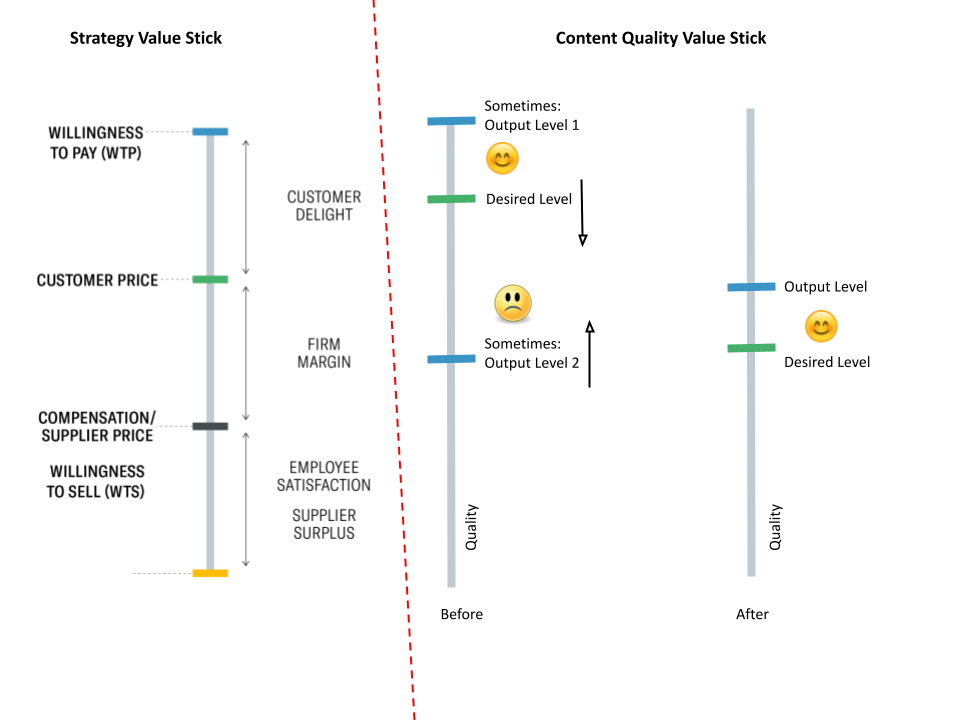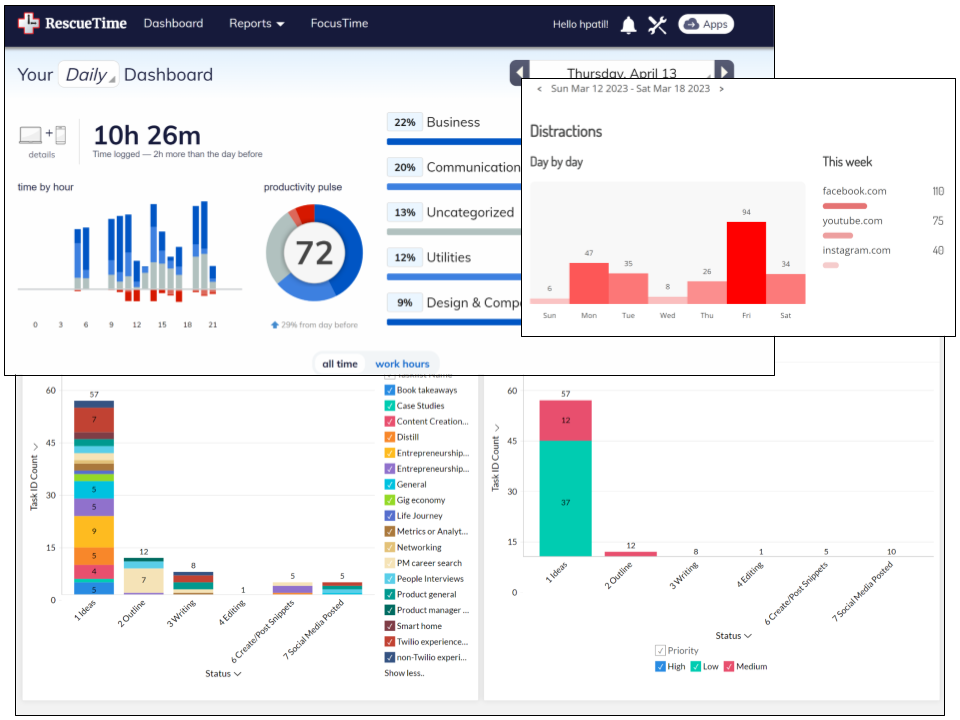Coping With 6 Challenges In Content Creation And Community Curation
- Harshal

- Apr 14, 2023
- 5 min read
How I Overcame Struggles To Create Content And Form Habits While Getting Comfortable With My Weaknesses
I started writing in 2020.
In 2021, I wrote 6 Challenges in Content Creation and Creating a Community.
Now, in 2023, I am comfortable coping with these challenges.
Thanks for all the inputs I received across several Lunchclub conversations, insights from Prateek Jain, Michael Lin, Nikitha Suryadevera, CopyThat from Sam Parr, and many more experienced writers.

Thumbnail credits Craiyon Search
A Content Quality Value Stick similar to the Strategy Value Stick
In each section of coping with a challenge, I have split it into two ways. I’ll illustrate it using the Strategy value stick from Harvard Business Review. I would be unhappy when the output level is lower than the desired level. And happy when the output level is higher than the desired level. What if I lower the desired level and raise the output level?

Coping with Challenge 1 - Depth and Editing time
Writing a long-form article was easier than distilling my thoughts into one paragraph. I felt satisfied writing in-depth pieces than superficial high-level commentary. But that meant a lot of time writing, editing, and reviewing.

Illustration using Dall-E.
I tried hiring writers to reduce the time. But I realized the tone didn’t match mine, nor did their writing provide an in-depth expert perspective. I tried ChatGPT, Copy.ai, Open AI Playground, Scalenut, but none helped me.
I reduced the time to reach desired quality through 2 directions:
Lower the quality level desired
Improve the quality level I create.
I lowered the desired quality level after realizing my most edited and planned out works, such as An Adventure in Solving Customer Problems and Tidying-up Metrics - Part 1 were hard to read. Whereas I was able to bring sufficient original perspectives in my off-the-cuff writings such as FAQs on becoming a Product Manager.
I improved my writing quality through
Reading the book Storyworthy by Matthew Dicks,
Reading the book On Writing Well,
Reading the book It Was the Best of Sentences, It Was the Worst of Sentences by June Casagrande,
Grammarly pro software,
Hemmingway App software,
And increasing my quantity of writing. See Problem Solving: Quantity vs. Quality | Ohio University.
Coping with Challenge 2 - Visual perfection
I love making my articles “me” by adding data, creating data visualizations, and curating illustrations to add to my writing. But a freelance writer couldn’t do the same. I didn’t want to spend on hiring illustrators as that would’ve gotten expensive.

Illustration using Dall-E.
I lowered the quality bar for illustrations while also speeding up my creation of them.
Lowering the quality bar:
Speeding up my creation of illustrations:
I delegated data gathering to VAs. For example, I hired a VA to get the book data in Measuring a year in books: My 2022 in review (Inspired by Spotify).
I accepted using stock photos.
I started using Craiyon, Dall-E 2, and Freepik more generously.
Through all the trials and iterations, I am quick to use Google Drawings to create illustrations or collages.
Coping with Challenge 3 - Habit Formation and Focus Time
When I did CopyThat copywriting course, I dedicated 30mins every evening to writing. I didn’t follow that time boxed approach after that.

I lowered my need for focus time. How? I became comfortable with not having a fixed schedule of writing. Not having a habit.
I increased the possibility of focus time. How?
I improved my productivity tools to create focus time (e.g. Rescuetime, deprocastinate) and Deep Work opportunities daily.
I improved my productivity habits such as setting a daily goal of using Pomodora technique for my entire work day.
I prepared a content backlog so that anytime I get time, I can jump back into the article that is the best use of my time. You can see it here using the password “sctzoho”.
Although I read 90+ books in 2022, I took a break from consuming content in early 2022 and around March-April 2023. When I stopped consuming content, it let my mind get the whitespace to think of content creation. This sped up my writing when I got to it.

Coping with Challenge 4 - Posting Schedule
Most content experts recommend publishing at least weekly, if not more frequently. If not weekly, choose another regular cadence for newsletters to not land in the dreaded Promotions tab in Gmail.
I improved on having a posting schedule.
I realized I have an accumulating pile of content. Many of which continue to be relevant today. Plus, each content is a long-form article, which enables me to post it in different formats and share varied perspectives I’ve already written. So, I can reuse earlier posts to post on LinkedIn, Twitter, and other communities with an audience.
I trialed a few freelancers who would read through my content and recycle it into short-form articles. I got each long-form article broken down into 2-5 social media posts.
I used scheduling tools on Twitter, LinkedIn, and Slack to bulk-create short pieces and have a pipeline.

Coping with Challenge 5 - Building an Audience
The larger the audience, the better. My social media posts get low levels of engagement. However, I’ve lowered my desired output. After interviewing 40+ consultants and some webinar primary research, I realized having a social media presence benefits in being top of mind amongst your friends/acquaintances, irrrespecitve of fan following through comments and likes.
So, I dropped the desired output to only be my input effort of posting regularly on social media, not about the number of interactions it generates.
I upped my output level by setting the target of one post a week and hiring a freelancer to write those posts, as I discussed in the previous section.

Coping with Challenge 6 - Matching Audience and Content
Ideally, I should match the content to the audience. However, I didn’t research my audience's needs to write for it.
I lowered my desired output by setting the goal to write whatever caught my fancy. I will not notify readers if I write an unusual article. My goal now is to “throw spaghetti on the wall and see what sticks.”
I will be more targeted after I reach either of these two stages. 1) Defining my consulting niche from the market research. 2) Burning through my content backlog. You can see my content backlog here using password “sctzoho”.
I upped my output level by listening to users of my resume parser and creating video content catering to their needs.

What else works for you?
Which of these challenges have you experienced?
How did you tackle the ones that are not a challenge for you?








